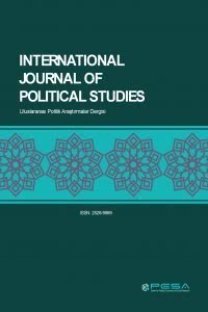THE POTENTIAL ROLE OF TURKEY TOWARD A REGIONAL HUMAN RIGHTS ARRANGEMENT IN ASIA
The purpose of this paper is to discover the possibilities for establishing a regional human right instrument and respective enforcement mechanism in Asia and the potential role of Turkey in that regard. The examples of three existing regional human right systems indicate that such establishments significantly contribute to the protection and development of human rights and freedoms. It is often argued that the distinct features of Asia hinder a concrete regional project in terms of human rights. This account, however, ignores recent human rights movements in the region. Recent developments strengthen the hope toward a credible Asian human rights mechanism. It must be also noted, even mere efforts be it political or civil to build such a system will greatly contribute to the development of human rights by raising public awareness and furthering capacity building. In other words, not only the goal but also the process itself to attain this goal is highly valuable in terms of human rights protection. Of course, political dedication is the pillar of a regional system. In that regard, Turkey may play a crucial role in leading such efforts along with other democratic states in the region. As a democratic country and welldeveloped economy, together with its geopolitical position and historical ties, Turkey should undertake concrete steps for establishment of regional cooperation for human rights protection.
Anahtar Kelimeler:
Regional Human Rights Instruments, Sub-regional Human Rights Organizations, ASEAN, AICHR, AACC, Intergovernmental Organizations, Asian Human Rights Court, National Human Rights Institutions, Human Rights Civil Society Organizations
___
- EP, (European Parliament Directorate-General for External Policies Policy Department) (2010) The Role of Regional Human Rights Mechanisms, EU Doc EXPO/B/DROI/2009/25 http://www.europarl.europa.eu/RegData/etudes/etudes/join/2010/410206/EXPODROI_ ET(2010)410206_EN.pdf 28.09.2015 UN, (United Nations Human Rights, Office of the High Commissioner for Human Rights, Regional Office for South-East Asia) (2009) Report of Expert Dialogue with Civil Society and NHRIs on Regional Human Rights Mechanisms in Africa, the Americas and Europe http://bangkok.ohchr.org/programme/asean/report_jakarta_workshop.pdf 25.9.2015 ASEAN, (Association of Southeast Asian Nations) (2010) Terms of Reference,http://www.asean.org/storage/images/2012/Social_cultural/ACW/TOR-ACWC.pdf. 1.9.1015 AICHR, (Asian Intergovernmental Commission on Human Rights) (2014) What You Need to Know, 2nd edition, The ASEAN Secretariat, aichr.kln.gov.my/index.php/documents?download=1:aichrbooklet. 1.9.2015 TCC, (Turkish Constitutional Court) (2016) Annual Report of 2015, The Constitutional Court of Turkey, http://www.constitutionalcourt.gov.tr/inlinepages/publications/pdf/annualreport2015.pdf Durbach, Andrea, Renshaw, Catherine & Byrnes, Catherine (2009), ‘A tongue but no teeth?: The Emergence of a Regional Human Rights Mechanism in the Asia Pacific Region.” 31 Sydney L. Rev. 211. Phan, Hao Duy (2009), “A Blueprint For a Southeast Asian Court Of Human Rights,” 10 Asia-Pac. J. on Hum. Rts. & L. 385. Ginsburg, Tom (2008), “Constitutional Courts in East Asia: Understanding Variation,” 3 Journal of Comparative Law 80. Yanık, K. Lerna, “The Metamorphosis of Metaphors of Vision: ‘Bridging’ Turkey's Location, Role and Identity After the End of the Cold War” Geopolitics, Vol. 14, 2009, Issue 3, 531−549. Kim, Jina, “Developments of Regional Human Rights Regime: Prospects for and Implications to Asia”, http://www.tokyofoundation.org/sylff/wp-content/uploads/2009/03/sylff_p57-1022.pdf. 28.9.2015 Kramer, Heinz, “Will Central Asia Become Turkey’s Sphere of Influence” http://sam.gov.tr/tr/wpcontent/ uploads/2012/01/8.-WILL-CENTRAL-ASIA-BECOME-TURKEYS-SPHERE-OFINFLUENCE. pdf
- Başlangıç: 2015
- Yayıncı: Politik Ekonomik ve Sosyal Araştırmalar Merkezi
Sayıdaki Diğer Makaleler
“YENİ DÜNYALAR ESKİ METİNLER” - ANTHONY GRAFTON
Armando ALİU, İlyas ÖZTÜRK, Dorian ALİU, Ömer ÖZKAN
GELENEKSEL DEVLETTEN MODERN DEVLETE: SANAYİ DEVRİMİ VE KAMU YÖNETİMİ DÜŞÜNCESİNDE DEĞİŞİM
CHP, SOSYAL DEMOKRASİ VE SOL - YUNUS EMRE
ISLAMIC POLITICS IN CONTEMPORARY INDONESIA
GÜNCEL RAPORLAR IŞIĞINDA AVRUPA’DA YÜKSELEN İSLAM DÜŞMANLIĞI
ADALET VE KALKINMA PARTİSİ’NİN DİN POLİTİKALARINDA ETKİLİ OLAN TEMEL DİNAMİKLER
THE POTENTIAL ROLE OF TURKEY TOWARD A REGIONAL HUMAN RIGHTS ARRANGEMENT IN ASIA
